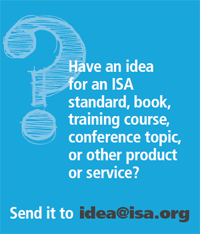- By Jim Federlein, PE
- Standards
Summary
By Jim Federlein, PE
Accurate, reliable, and repeatable operation of monitoring and control loops in industrial automation and control systems (IACSs) is vital to maintaining the safety and reliability of a production facility. Where repeatable measurements take place in the monitoring or control of a facility, the measuring instruments and test equipment must have repeatable outputs. A well-planned calibration program, correctly implemented and maintained, directly contributes to achieving the desired operation.
A new recommended practice (RP), ISA-RP105.00.01-2017, Management of a Calibration Program for Industrial Automation and Control Systems, sets forth a basic framework for developing and maintaining a consistent calibration program for IACSs-including instrumentation used in safety instrumented systems. It provides guidance on methodologies for calibration of an IACS by considering the accuracy required by the process of each loop and, if necessary, adjusting loop components to achieve the desired loop or component accuracy.
The need for the guidelines was identified by former ISA President Leo Staples, senior manager, utility operational compliance, OG&E, since retired, based on a highly successful calibration program he developed. The ISA105 committee determined that the format of an RP, which gives recommended guidelines, as opposed to a standard with mandatory requirements, would enable users from multiple industries and applications to decide how to apply the practices most effectively for their specific needs.
Importance of a calibration program
Without a calibration program, maintenance of control, indication, and analytical devices and systems often occurs only when the error in reading is large enough to be obvious to facilities personnel. Operations and maintenance personnel routinely make decisions based on these devices. A faulty indication on such a device could lead to the release of energy or another unsafe action.
In contrast, a well-planned and implemented calibration program establishes periodic assessments of loop/component performance over time. Data acquired during these assessments not only helps establish future calibration intervals, but is critical for the allocation of capital and operational resources. Clearly defined policy and procedures support the efforts of maintenance planners to schedule adequate labor and equipment for calibration both during and between facility outages. Following established calibration procedures and using correct equipment reduces the likelihood of human errors due to incorrect practices, prevents acting on incorrect information, ensures the desired results of the calibration efforts, and promotes the correct operation of an IACS. Further, targeted reduction or increase in calibration activities based upon the assessment of data derived from an instrument asset management calibration program can both reduce maintenance costs and improve reliability and safety.
The new RP is a baseline definition and model of a quality management system that can be used to implement and maintain a calibration program for an IACS. It covers topics including:
- planning a calibration program-encompassing required loop tolerances, confirmation intervals, and calibration personnel, equipment, procedures, and record systems
- verifying loop and component performance
- managing the program
Key concepts of the RP include:
- the importance of a well-planned calibration program to facility operation safety and desired operation
- the importance of monitoring the calibration program implementation and making corrections/improvements when necessary
- calibration of a loop rather than the more common focus on field instruments only
- setting reasonable goals for the performance of each loop (i.e., loop tolerance) rather than just using the rated accuracy of the field instrument
- the difference between test equipment (which is used to check the operation of a loop/component) and calibration equipment (which is used to adjust a component)
- instrumentation based on newer technology (such as "smart" devices), which is more accurate and more stable than devices based on older technology, requiring less frequent calibration monitoring but more accurate calibration equipment
This approach to calibration has proven successful when users adhered to the concepts set forth in these guidelines, giving their organizations the full benefits of a standardized approach to calibration.
For information on viewing or obtaining ISA-RP105.00.01-2017, visit www.isa.org/findstandards. For information on the ISA105 committee, Commissioning, Loop Checks, and Factory & Site Acceptance/Integration Tests for Industrial Automation Systems, contact Charley Robinson, ISA Standards, crobinson@isa.org

Reader Feedback
We want to hear from you! Please send us your comments and questions about this topic to InTechmagazine@isa.org.


